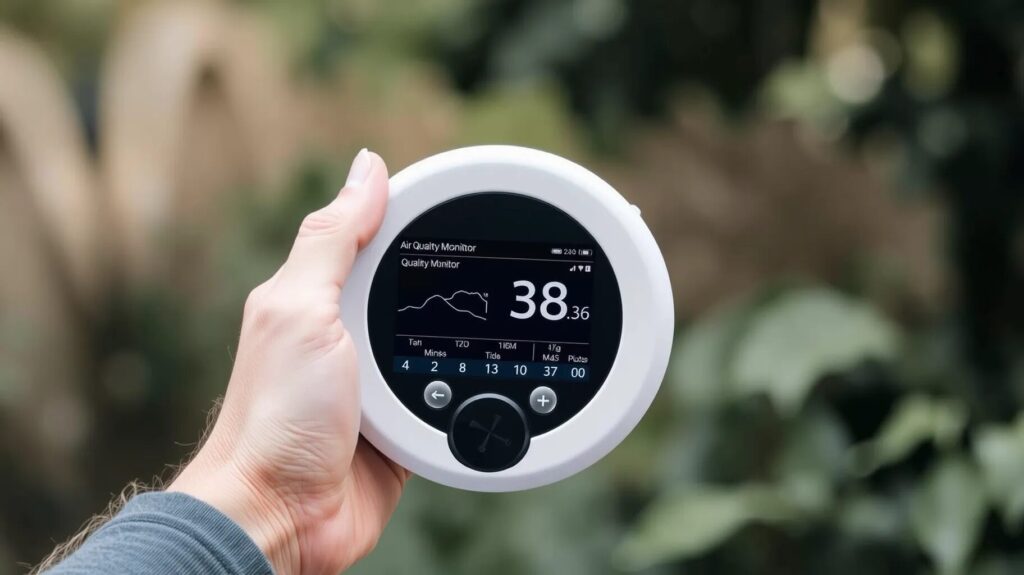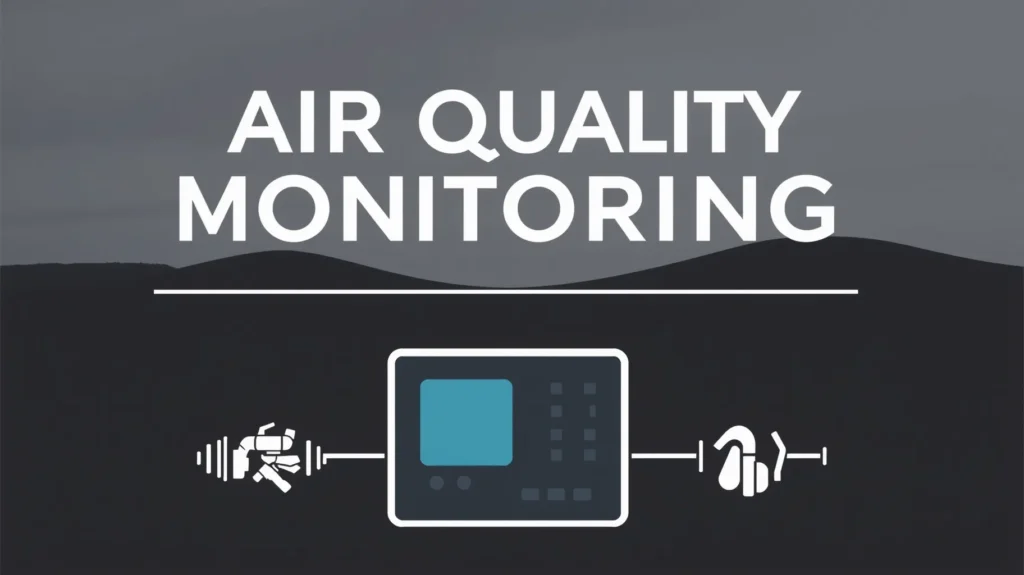
The issue of air quality has become a pressing concern for communities and governments worldwide. As populations grow and industries expand, pollutants in the air continue to rise, impacting both public health and the environment. Traditional air quality monitoring systems, while effective, have limitations—often in terms of real-time data accuracy, coverage, and response time.
But there’s a new player in town: Artificial Intelligence (AI). AI is transforming air quality monitoring in ways that could not have been imagined just a decade ago. From predictive analysis to real-time tracking, AI offers a smarter, faster, and more efficient approach to keeping our air clean.
AI Enhancing Real-Time Air Quality Monitoring
Traditional air monitoring relies on physical stations that gather data at set locations. However, these stations are often few and far between, leaving gaps in information, especially in rural or underdeveloped areas. AI-powered systems, on the other hand, use data from multiple sources, including satellite imagery, traffic patterns, and even social media reports, to provide a real-time snapshot of air quality across vast areas. This way, rather than waiting for readings from a single station, cities can now access continuous updates.
What’s more, AI doesn’t just gather data—it learns from it. By analyzing historical patterns, weather conditions, and pollution sources, AI can predict air quality hours or even days ahead, giving communities time to act before pollution levels reach dangerous thresholds.
Predictive Analytics and AI: A Powerful Combo
One of AI’s most groundbreaking contributions is in predictive analytics. Using machine learning algorithms, AI systems can forecast future pollution levels based on current trends. By feeding massive datasets into these models—such as vehicle emissions, industrial activity, and weather patterns—AI can predict when and where air quality will deteriorate.
This capability allows city planners, businesses, and environmental agencies to act preemptively. Imagine a city that knows a week in advance that certain areas will face poor air quality due to a weather shift. With that foresight, they can initiate temporary traffic restrictions, industrial slowdowns, or even advise residents to stay indoors.
Affordable and Scalable Solutions
Traditional monitoring systems can be quite costly. High-tech sensors, installation, and maintenance costs make comprehensive coverage expensive. AI can change that. By combining data from low-cost sensors, drones, and mobile devices, AI-driven systems reduce the overall expenses while increasing the monitoring network’s reach.
Because AI doesn’t need thousands of physical stations, it offers a scalable solution. Whether monitoring is needed for a single neighborhood or an entire city, AI adapts and expands as required. This flexibility makes air quality tracking more accessible for smaller towns and developing nations, which often suffer from the worst pollution but have the least resources to combat it.
Precision Targeting of Pollution Sources
Another advantage of AI is its ability to identify the exact source of pollutants. Traditional methods struggle to pinpoint the precise origin of emissions, often leading to generic recommendations that don’t address the root cause. With AI, however, systems can analyze traffic patterns, industrial output, and even natural factors like wildfires to identify specific pollution sources.
For instance, in urban areas, AI can differentiate between emissions from vehicles, factories, and residential heating systems. This level of detail helps authorities focus their efforts more effectively. Instead of blanket policies, they can implement targeted solutions—like adjusting traffic flows or working with certain industries to reduce emissions during peak pollution times.
AI-Driven Citizen Science and Engagement
Interestingly, AI isn’t just for governments and big organizations. Citizen scientists are now getting involved in air quality monitoring thanks to AI-powered apps and devices. With affordable sensors and mobile apps, people can monitor the air quality in their homes, neighborhoods, or workplaces and share the data with larger networks.
This crowdsourced data feeds into AI algorithms, providing a broader and more accurate understanding of air quality trends. In turn, this empowers communities to advocate for cleaner air policies or take action themselves, such as organizing local car-free days or planting trees in high-pollution zones.
Smart City Integrations: AI and Urban Planning for Cleaner Air

As urban areas expand, so do the challenges in maintaining healthy air quality. Cities around the world are turning to AI to integrate air quality monitoring into their smart city initiatives. AI can help manage traffic flow, monitor industrial emissions, and even optimize energy use in real-time, all while keeping tabs on air pollution levels.
For example, AI-powered systems can manage traffic lights to reduce congestion, which in turn lowers vehicle emissions. By analyzing real-time traffic data, these systems can reroute vehicles away from pollution hotspots, leading to cleaner air. Additionally, smart grids powered by AI can control energy consumption in cities, reducing the reliance on fossil fuels and promoting cleaner, more sustainable alternatives.
Health Impacts and AI-Powered Alerts
The link between air quality and public health is well established. Poor air quality contributes to respiratory conditions, heart disease, and even cognitive decline over time. AI’s ability to provide real-time alerts about pollution spikes means that health professionals and the public can respond quickly.
For example, AI systems can issue notifications to residents when air quality reaches dangerous levels, advising them to stay indoors or wear masks. These real-time alerts are especially important for vulnerable populations like children, the elderly, and those with pre-existing health conditions. Some systems can even be connected to wearable devices, allowing individuals to receive personalized recommendations based on their specific health needs.
Furthermore, AI can assist medical professionals by analyzing the correlation between air quality data and hospital admissions. This data-driven approach can help health services better prepare for and respond to pollution-related health emergencies.
AI and Climate Change: The Bigger Picture
Air pollution isn’t just a local issue—it’s a global one, intricately tied to climate change. Greenhouse gases like carbon dioxide (CO2) and methane (CH4) contribute to both global warming and the degradation of air quality. AI plays a significant role in identifying and reducing these emissions on a global scale.
AI-powered systems can track emissions across borders, industries, and ecosystems, providing governments with the data they need to enforce stricter regulations. AI can also help businesses optimize their production processes to reduce emissions, making them more energy-efficient and eco-friendly.
Moreover, AI’s predictive capabilities can help model the future impact of current emissions on both local air quality and the global climate. This allows policymakers to take proactive steps to mitigate the worst effects of pollution and climate change before they happen.
Personal Air Quality Monitoring Devices
Gone are the days when only government officials could monitor air quality. With AI-driven personal monitoring devices, individuals can now track the air quality in their immediate environment. These devices, which are often compact and portable, use AI to analyze pollutants in real-time, providing users with immediate feedback.
People living in high-pollution areas or those with health concerns can benefit from these gadgets by receiving AI-generated recommendations. For instance, if the device detects high levels of particulate matter, it may advise you to avoid outdoor activities or to use an air purifier indoors. Over time, the AI learns your preferences and health needs, offering more tailored advice.
Applications of AI-Powered Air Quality Systems
- Urban Pollution Management
- Use Case: In densely populated cities, AI-driven air quality systems can help local governments monitor pollution sources and devise traffic and industrial policies to reduce emissions.
- Example: Delhi, one of the most polluted cities in the world, is piloting AI solutions to optimize traffic flows and limit vehicle emissions based on real-time air quality reports.
- Healthcare and Public Health Alerts
- Use Case: AI systems can monitor pollution levels and issue health alerts to residents, especially those with pre-existing respiratory conditions like asthma.
- Example: Cities like New York have mobile apps that notify citizens when air quality drops below healthy levels, advising vulnerable populations to stay indoors or wear masks.
- Industrial Emissions Control
- Use Case: Factories and industrial complexes use AI to track their emissions and ensure compliance with environmental regulations. AI systems can automatically adjust processes to reduce emissions when air quality thresholds are met.
- Example: AI in China’s steel industry helps predict pollution surges and automatically alters manufacturing processes to limit emissions during peak pollution hours.
- Wildfire Detection and Response
- Use Case: AI-powered air quality systems, integrated with satellite imagery, can detect wildfires early, allowing faster response and more accurate predictions of smoke drift, which impacts air quality.
- Example: In California, AI models track wildfire smoke in real-time, providing essential information for emergency responders and residents to protect air quality.
Challenges and Limitations of AI in Air Quality Monitoring
- Data Quality and Availability
- Problem: Many regions, particularly developing countries, lack sufficient data infrastructure to support AI-powered air quality monitoring, leading to data gaps.
- Potential Solution: AI-driven initiatives could focus on democratizing low-cost sensors and global data-sharing platforms to improve data quality in underserved regions.
- Computational Requirements
- Problem: AI models require significant computational resources, especially when processing data from multiple modalities (e.g., satellite, sensor, and weather data).
- Potential Solution: Advancements in edge computing and cloud-based AI platforms can reduce the computational burden and increase efficiency.
- Privacy and Data Security
- Problem: The use of widespread air quality sensors, especially in urban areas, raises concerns about data privacy and surveillance.
- Potential Solution: Implementing robust data security measures, like encryption and anonymization protocols, will be essential to maintaining public trust in AI-driven air quality systems.
Role of AI in Reducing Indoor Air Pollution
While outdoor pollution grabs the headlines, indoor air quality is equally important. Poor ventilation, the use of certain cleaning products, and emissions from cooking can all contribute to unhealthy indoor environments. AI-powered air quality monitors are being used in homes, offices, and schools to track and improve indoor air quality.
These smart devices can connect to heating, ventilation, and air conditioning (HVAC) systems to adjust airflow or activate air purifiers when needed. Some can even suggest natural ventilation strategies, like opening windows at certain times, based on weather and air pollution data. Over time, AI learns the best ways to maintain clean air in a specific indoor environment, creating a healthier living and working space.
The Future of AI in Air Quality Monitoring
The future of air quality monitoring is undeniably tied to the development of AI technologies. As AI continues to evolve, its applications in this field will only expand. One potential development is the use of AI-powered drones that can monitor hard-to-reach areas, like industrial zones, forests, and remote regions.
Additionally, the combination of AI with blockchain technology could lead to more transparent air quality monitoring systems. Blockchain can ensure the data collected is tamper-proof, providing more reliable information to governments and citizens alike.
Another exciting frontier is the integration of AI with smart cities and the Internet of Things (IoT). In this vision, everything from street lamps to traffic lights will be connected, feeding data into AI systems that continuously monitor and improve air quality. Imagine living in a city where every breath you take is cleaner, thanks to the hidden network of AI systems working behind the scenes.
Conclusion: AI and the Quest for Cleaner Air
Artificial intelligence is undeniably transforming the way we monitor and manage air quality. From real-time tracking and predictive analytics to personalized health recommendations and smart city innovations, AI is a powerful tool in the fight for cleaner air. As AI technologies continue to improve, their impact on air quality monitoring will become even more pronounced, offering hope for healthier cities, cleaner environments, and a future where breathing easy is no longer a luxury, but a right.
Through collaboration between governments, industries, and citizens, AI has the potential to drastically improve air quality across the globe. And as the technology becomes more widespread and accessible, we might find that AI is not just a tool for monitoring the air we breathe—it’s a tool for changing it.
Frequently Asked Questions (FAQ) on AI Transforming Air Quality Monitoring
Q1: How does AI improve air quality monitoring compared to traditional methods?
- Answer: AI enhances air quality monitoring by providing real-time data, predictive analytics, and broader coverage. Unlike traditional methods that rely on fixed stations, AI can gather information from multiple sources like satellites, traffic patterns, and social media, resulting in more accurate and up-to-date air quality assessments.
Q2: What types of data does AI use to monitor air quality?
- Answer: AI systems utilize data from various sources, including satellite imagery, traffic data, weather reports, industrial emissions, social media, and low-cost sensors. This multi-source data integration enables AI to create a comprehensive and dynamic picture of air pollution levels.
Q3: How does AI predict future air quality levels?
- Answer: AI employs machine learning algorithms to analyze historical pollution data, weather patterns, traffic trends, and industrial activities. By recognizing patterns and correlations, AI can forecast air quality changes, allowing authorities to prepare and respond proactively.
Q4: Can AI pinpoint the sources of air pollution?
- Answer: Yes, AI can identify specific pollution sources by analyzing data from multiple inputs, such as traffic emissions, factory outputs, and natural events like wildfires. This precision allows for targeted solutions, making it easier to address the root causes of air pollution.
Q5: How is AI integrated into smart city projects for air quality management?
- Answer: AI is increasingly used in smart city projects to manage traffic flow, control industrial emissions, and optimize energy usage. By integrating AI with the Internet of Things (IoT), cities can continuously monitor air quality, adjust traffic patterns, and activate air purifiers or alert systems as needed.
Q6: Are there AI-powered devices available for personal air quality monitoring?
- Answer: Yes, AI-driven personal air quality monitors are available and growing in popularity. These devices use AI to analyze real-time air quality data, providing users with immediate insights and recommendations to protect themselves from harmful pollutants.
Q7: How can AI contribute to reducing indoor air pollution?
- Answer: AI can help manage indoor air quality by controlling HVAC systems and air purifiers based on real-time air quality readings. Smart AI monitors can detect harmful indoor pollutants and adjust ventilation or purification systems to maintain a healthier indoor environment.
Q8: Is AI-based air quality monitoring expensive?
- Answer: While traditional air monitoring stations can be costly, AI-powered solutions can be more affordable and scalable. Using low-cost sensors, drones, and even smartphones, AI-driven systems can reduce costs while expanding coverage, making air quality monitoring accessible to more communities.
Q9: How reliable are AI predictions for air quality?
- Answer: AI predictions are highly reliable due to the vast amounts of data they analyze. However, like any predictive system, the accuracy depends on the quality and quantity of the data input. As AI systems continue to learn and adapt, their predictions become increasingly accurate.
Q10: Can AI help in the fight against climate change through air quality monitoring?
- Answer: Absolutely. AI’s ability to monitor and analyze air quality helps identify major greenhouse gas sources, making it easier to address these issues. By providing actionable insights, AI can guide efforts to reduce emissions and contribute to global climate change mitigation strategies.
Q11: How do governments use AI for air quality regulation?
- Answer: Governments use AI to monitor pollution levels in real-time, enforce regulations, and predict pollution hotspots. This data-driven approach helps in drafting policies, implementing traffic restrictions, and regulating industrial emissions more effectively.
Q12: How can citizens participate in AI-driven air quality monitoring?
- Answer: Citizens can contribute by using personal air quality monitoring devices or smartphone apps that collect and share data. This crowdsourced information feeds into AI systems, creating a more comprehensive picture of air quality trends and empowering communities to advocate for cleaner air.
Q13: What role do wearable devices play in AI air quality monitoring?
- Answer: Wearable devices equipped with AI sensors can track the air quality around an individual and provide personalized recommendations, especially for those with respiratory issues or sensitivities. These wearables are increasingly being used to offer real-time alerts about exposure to harmful pollutants.
Q14: Can AI help in tracking air quality in remote or hard-to-reach areas?
- Answer: Yes, AI-powered drones and satellite data can monitor air quality in remote regions where traditional monitoring stations may not be feasible. This expanded reach ensures more comprehensive coverage, even in challenging environments.
Q15: What are the challenges of using AI in air quality monitoring?
- Answer: Some challenges include the need for high-quality data, integrating diverse data sources, and ensuring public access to the data collected. Additionally, there can be concerns around privacy and data security, especially when using personal monitoring devices or crowdsourced data.
Q16: How does AI contribute to public health in the context of air quality?
- Answer: AI helps improve public health by providing real-time air quality alerts, predicting pollution trends, and offering personalized health advice. This enables vulnerable populations to take preventive measures and helps healthcare providers better understand the impacts of air pollution on community health.
Resources
- World Health Organization (WHO) – Air Pollution
- WHO provides extensive research and reports on global air quality and its impacts on health, along with policy recommendations.
- Visit WHO Air Pollution page
- Environmental Protection Agency (EPA) – Air Quality Monitoring
- The U.S. EPA offers a wealth of information on air quality monitoring, pollution sources, and data collection methods, including insights into AI’s role in improving these processes.
- Visit EPA Air Quality page
- Google AI Blog – Environmental Insights Explorer
- Google’s AI team has developed several tools for monitoring environmental factors, including air quality. The Environmental Insights Explorer uses AI to gather and analyze data from cities worldwide.
- Visit Google AI Blog
- IQAir – Air Quality and Pollution City Ranking
- IQAir offers real-time air quality monitoring data, ranking cities worldwide based on pollution levels. Their reports frequently discuss the use of AI and advanced tech in tracking air pollution.
- Visit IQAir
- UNEP – United Nations Environment Programme: Air Quality
- UNEP highlights how AI and big data can address environmental challenges, including air quality management, with in-depth case studies and strategies for sustainable solutions.
- Visit UNEP Air Quality page
- Harvard T.H. Chan School of Public Health – Air Pollution Research
- Harvard’s public health school conducts cutting-edge research on the health effects of air pollution, integrating AI for more accurate health predictions related to air quality.
- Visit Harvard Public Health Research
- Accenture – AI in Environmental Management
- Accenture explores how AI is being leveraged in environmental management, including air quality monitoring, showcasing practical applications for cities and industries.
- Visit Accenture AI page
- IBM – AI and Weather Forecasting
- IBM is at the forefront of using AI to improve weather forecasts and environmental monitoring, including air quality tracking. Their insights into AI applications offer a comprehensive view of what’s possible.
- Visit IBM AI page
- European Environment Agency (EEA) – Air Quality in Europe
- The EEA provides up-to-date information on air pollution across Europe, utilizing AI and data analytics to track trends and predict future air quality challenges.
- Visit EEA Air Quality page
- Microsoft AI for Earth Program
- Microsoft’s “AI for Earth” initiative provides tools and resources to use AI in addressing environmental issues, including air quality monitoring solutions.
- Visit Microsoft AI for Earth





